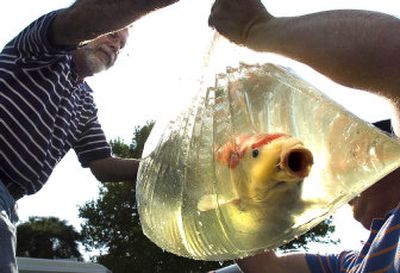Riverfront Park cozies up to koi

On the count of two, volunteers carefully hoisted the plastic bag holding Sunny, a white fish with a brilliant red spot on its forehead. They gently transferred it from a small examination tub into the blue 324-gallon vinyl tank where it will spend the remainder of the weekend.
Measuring longer than 20 inches, Sunny resumed its place among the other koi that Spokane resident Linda Seifert entered in this weekend’s seventh annual Koi and Goldfish Show at Riverfront Park.
The show, moved for the first time from Spokane County’s fairgrounds to the downtown park, doesn’t start until this morning. But the flashy orange, red, black and blue of the koi attracted a bevy of passersby Friday afternoon during check-in, many of whom were impressed with the sheer size of the fish and eagerly took pictures with camera phones.
“That fish is bigger than the cat,” sad Rachel Baer, 23, of Spokane.
Free for the first time this year, the event features many types of koi, which can cost more than $100,000, grow to several feet long and live for several decades. Sunny is a Tancho, a type of koi revered because its characteristic red mark resembles the red disc on Japan’s flag, said Dick Benbow, who examines the koi before they are allowed into the show.
About 60 koi were checked in as of Friday evening, and one organizer estimated twice that number may participate.
A type of carp, koi originally came to the U.S. from Japan, and several owners participating in the show have traveled there to pick out their pets. People commonly assume koi and goldfish are related, but they are genetically dissimilar, said longtime koi and goldfish owner John Seifert, Linda’s husband.
“They’re peaceful,” Linda Seifert said of koi. “They’re beautiful. They’re friendly. They’ll eat out of your hand.”
Linda Seifert, 59, entered nine koi and several goldfish. She has been raising for about 12 years, and she took first place at the society’s first show, she said.
“It becomes an addiction, and that addiction is koi kichi,” meaning koi crazy, she said.
Owners at the event varied in age and experience, but most said they raise koi for camaraderie and the enjoyment of keeping the fish rather than the competition.
Koi generally aren’t eaten in the U.S., but they are sold as sushi in Asia. And raccoons, cats, herons and other predators find koi that are kept in outdoor ponds to be a tasty treat. The Seiferts have lost two to herons, Linda Seifert said.
Dead fish aren’t cheap to replace. First-time entrant Randy Patterson, 47, of Spokane, has about 24 koi that cost between $5 and $800 dollars, he said.
Older koi and those from pure Japanese bloodlines cost more. Female koi may lay thousands of eggs, but breeders select only a small fraction of the young fish to be worthy of entering contests.
Keeping koi requires not only protecting them from predators but keeping their water the proper temperature and regulating the oxygen, pH and ammonia levels of their tanks.
Three judges, including one from Tennessee and one from Chicago, will grade the koi and goldfish on a variety of categories today.
Not everyone who stopped was enthralled with the fish.
“They’re huge, yes, but they’re expensive for looking like really big goldfish,” said Nick Conklin, 18, of Spokane.
The show, organized by the Inland Empire Water Garden & Koi Society, runs 10 a.m. to 5 p.m. today and 10 a.m. to 2 p.m. Sunday. Judges will discuss the fish at 11 a.m. Sunday.